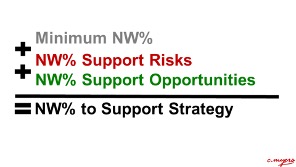3 minutes
Remaining relevant requires constant investment. At the same time, safety and soundness is paramount.
You know you need to move the business forward, but an uncertain financial future makes it tough to decide which strategic investments should be made now and which can wait. Seeking the best balance between financial safety and strategic advancement is never simple, and is especially complex today.
Since the pandemic hit, financial institutions have arguably been moving even faster than before on strategic initiatives. Digital channels in particular have been accelerated, which makes it easy to get left behind in that arena. Remaining relevant requires constant strategic investment. At the same time, financial safety and soundness is paramount.
One thing that can make this balancing act easier is dialing in with a bit more precision on what safety and soundness means for the institution. Having more clarity on how much net worth is needed to cover risks can help you gauge which strategic opportunities can be funded now.
As an example, imagine a $1 billion credit union that historically has 11% net worth. Having just finished a year with robust deposit growth from a flight to safety, net worth is down to 10%. Three years from now, stakeholders want to get net worth back up to 11%. Factoring in 8% annual asset growth, reaching 11% requires earning an ROA of 1.14% for the next three years. That translates to $12.6 million more in profits than would be needed to keep net worth at 10%.
At the same time, the credit union wants to make some major strategic advancements to maintain and improve relevancy. What kinds of strategic initiatives could be funded over the next three years with $12.6 million? Now the difficult decisions need to be made whether to invest in the strategic advancements and live with lower net worth or hold off in order to improve short-term profitability and build net worth. These decisions are far easier to make when the reasons for needing 11% versus 10% are understood. Quantifying the strategic net worth requirement can provide this clarity.
The strategic net worth requirement is the net worth needed to cover aggregate risks and strategic opportunities. Aggregating material risks from various areas of the business involves analysis and quantification of the unique risks for the institution, including credit risk, interest rate risk, regulatory risk and fraud, to name a few. Strategic opportunities are quantified, too, and factored into the net worth requirement along with the minimum net worth and net worth to support risks.
Strategic Net Worth

If the credit union in the example quantifies its strategic net worth requirement, what might you do in these scenarios?
- Strategic net worth requirement is 8%. The credit union has 10%. The credit union can choose to make its desired investments in strategic opportunities without dropping below 8%.
- Strategic net worth requirement is 12%. The credit union has 10%. The credit union might choose to eliminate some of the investments in strategic opportunities to lower its strategic net worth requirement. (If, after eliminating all investment in strategic opportunities, the strategic net worth requirement is still over 10%, the issue shifts from one of strategic advancement to one of safety and soundness.)
Quantifying your unique strategic net worth requirement helps stakeholders understand the true cost of building net worth, especially when there are tough decisions to be made on what to invest in when standing still isn’t an option.
Every organization’s risks and strategic opportunities are different. There is no one net worth ratio that works for all. There is a history for some in the industry of managing to a net worth ratio that “feels comfortable,” which often represents a ratio that “we’ve always had.” An analysis and quantification of material risks puts a finer point on how much really needs to be kept in the piggy bank and why.
There is no replacement for quality discussions with stakeholders, especially when the decisions are significant and difficult. Quantifying your strategic net worth requirement provides critical input for those discussions so stakeholders can make better decisions on balancing the deployment of net worth to move the strategy forward, while retaining enough to prepare for the unexpected.
c. myers helps financial institutions take control of their future by linking strategy, desired financial performance, and consistent execution with the right talent. Their experience and thought leadership allows them to work as a strategic collaborator and help uncover opportunities that result in continuous business model optimization. They have the experience of working with over 600 financial institutions, including 50% of those over $1 billion in assets and about 25% over $100 million. c. myers helps credit unions think to differentiate and drive better decisions through strategic planning & business model optimization, strategic solutions and implementation, strategic leadership development, real-time ALM and financial planning, education, and thought leadership.





